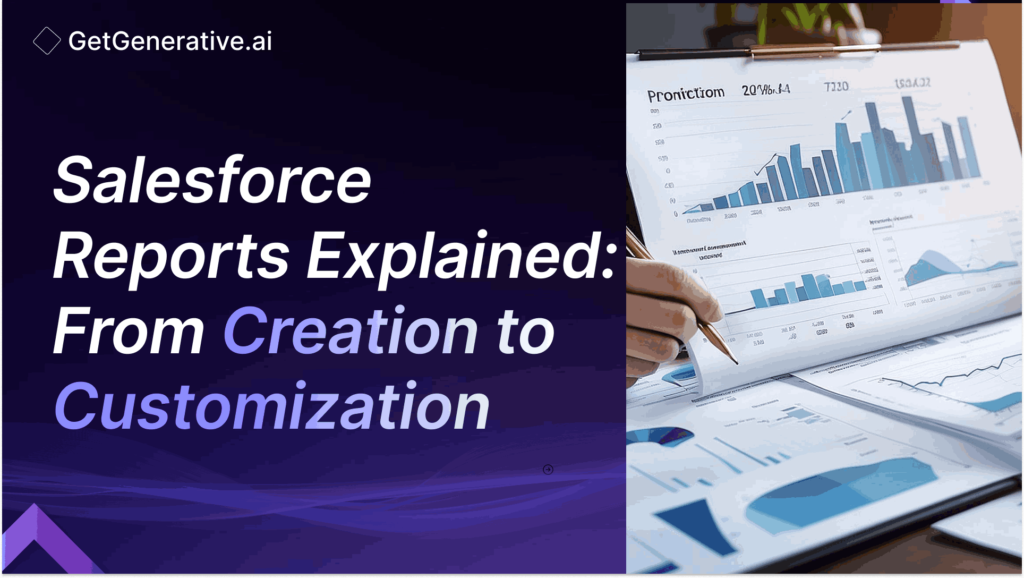Salesforce Reports Explained: From Creation to Customization
In today’s data-driven business landscape, the ability to extract meaningful insights from customer information is crucial for making informed decisions. Salesforce, the leading customer relationship management (CRM) platform, offers a powerful reporting feature that empowers organizations to turn their data into actionable intelligence. According to a recent Salesforce report, 84% of high-performing sales teams say data and analytics are critical to their success.
This comprehensive guide will explore Salesforce reports, their types, creation, customization, and best practices to help you harness the full potential of your customer data.
What are Salesforce Reports?
Salesforce reports are interactive tools that allow you to analyze and visualize your organization’s data. They comprehensively view your business operations, sales performance, marketing efforts, and more. Salesforce reports can be customized to display specific information, such as sales pipeline, customer activity, or lead conversion rates, enabling you to make data-driven decisions and optimize your strategies.
Types of Salesforce Reports
Salesforce offers a wide range of report types to suit the diverse needs of your business. Some of the most common types include:
- Tabular Reports: Tabular reports display data in a simple, spreadsheet-like format, making them ideal for quick, high-level overviews.
- Summary Reports: Summary reports group and aggregate data, providing a more detailed analysis of your information. They can track key metrics, such as revenue, opportunities, or customer activity.
- Matrix Reports: Matrix reports combine the features of tabular and summary reports, enabling you to analyze data across multiple dimensions (e.g., product vs. region, salesperson vs. quarter).
- Joined Reports: Joined reports allow you to combine data from multiple report types into a comprehensive view, offering a more holistic perspective on your business.
- Historical Reports: Historical reports track changes in your data over time, helping you identify trends and patterns.
Creating Reports in Salesforce
Salesforce makes creating and customizing reports to meet your specific needs easy. The reporting interface provides a user-friendly, drag-and-drop experience, allowing you to select the data fields, filters, and groupings you want to include in your report.
To create a new report, simply navigate to the “Reports” tab in Salesforce, click “New Report,” and choose the appropriate report type for your needs. Once you’ve selected the report type, you can further customize the report by adding filters, grouping data, and choosing the desired display format (e.g., chart, table, or both).
Also Read – Relationships in Salesforce: A Complete Guide
Custom vs. Standard Reports
Salesforce offers a wide range of standard reports that cover common business scenarios, such as sales performance, marketing analytics, and service metrics. These pre-built reports can be a great starting point, as they often include the most relevant data fields and metrics for a particular area of your business.
However, custom reports are necessary as your organization grows and your reporting needs become more complex. Custom reports allow you to create tailored views of your data, incorporating unique data fields, calculations, and layout options to meet your specific requirements.
How can I automate the generation of Salesforce reports?
Automating the generation of Salesforce reports can save your team valuable time and ensure that critical information is consistently available. Salesforce offers several features to help you automate your reporting processes:
- Scheduled Reports: You can schedule reports automatically at specified intervals, such as daily, weekly, or monthly. The generated reports can be emailed to designated recipients or saved to a specific location.
- Report Dashboards: Dashboards provide a centralized view of your most important reports, which can be refreshed and updated automatically on a schedule.
- Report Subscriptions: You can set up report subscriptions to have Salesforce automatically email a report to you or your team regularly.
- Report Notifications: Salesforce can send alerts when certain report conditions are met, such as a sales target being exceeded or a key metric falling below a specified threshold.
What are the best practices for designing effective Salesforce reports?
Designing effective Salesforce reports requires a thoughtful approach. Here are some best practices to keep in mind:
- Define Clear Objectives: Before creating a report, identify the questions you want to answer or the decisions you need to support. This will help you focus on the most relevant data and metrics.
- Keep It Simple: Avoid cluttering your reports with too much information. Stick to the essential data points and visualizations that support your objectives.
- Utilize Filters and Groupings: Leverage Salesforce’s filtering and grouping capabilities to help users quickly identify the most important insights.
- Leverage Formatting and Branding: Use consistent formatting, color schemes, and branding elements to make your reports visually appealing and easily understood.
- Test and Iterate: Regularly review your reports with end-users and gather feedback to refine and improve them.
How do I export Salesforce reports to Excel?
Exporting Salesforce reports to Excel is a straightforward process that can be accomplished in just a few steps:
- Navigate to the report you want to export.
- Click the “Export” button in the report’s toolbar.
- Select “Excel” as the export format.
- Choose the desired export options (e.g., format, columns to include).
- Click “Export” to download the report as an Excel file.
Exporting reports to Excel allows you to analyze and manipulate the data further and share it with colleagues who may not have direct access to Salesforce.
Also Read – Salesforce Products Explained: The Ultimate Guide
Can I schedule reports to run automatically in Salesforce?
Yes, Salesforce allows you to schedule reports to run automatically repeatedly. To set up a scheduled report:
- Navigate to the report you want to schedule.
- Click the “Schedule” button in the report’s toolbar.
- Configure the schedule settings, such as the frequency, time, and email recipients.
- Save the schedule.
Scheduled reports can be a valuable time-saving feature. They ensure that your team has access to the latest data and insights without the need for manual report generation.
Conclusion
Salesforce reports are powerful tools for transforming customer data into actionable insights. By understanding the different report types, mastering the creation and customization process, and following best practices for effective report design, you can unlock the full potential of your Salesforce investment and make data-driven decisions that drive business success.
Enhance your Salesforce consulting with GetGenerative.ai. Effortlessly craft outstanding proposals, enabling you to dedicate more time to providing exceptional client service.
Start today!
Frequently Asked Questions (FAQs)
1. How do I share Salesforce reports with others?
You can share Salesforce reports with other users by granting them access to the report or by adding them as subscribers to scheduled reports.
2. Can I combine data from multiple objects in a single report?
Yes, Salesforce’s joined reports feature allows you to combine data from multiple report types into a comprehensive view.
3. How do I create custom report types in Salesforce?
The Salesforce administrator creates custom report types and allows you to build reports based on custom objects or relationships between objects.
4. Can I create dashboards to visualize my Salesforce reports?
Yes, Salesforce dashboards provide a centralized view of your most important reports, allowing you to monitor key metrics and trends at a glance.
5. How do I troubleshoot issues with Salesforce reports?
If you encounter any issues with Salesforce reports, refer to the Salesforce documentation, seek support from the Salesforce community, or contact Salesforce support for assistance.




